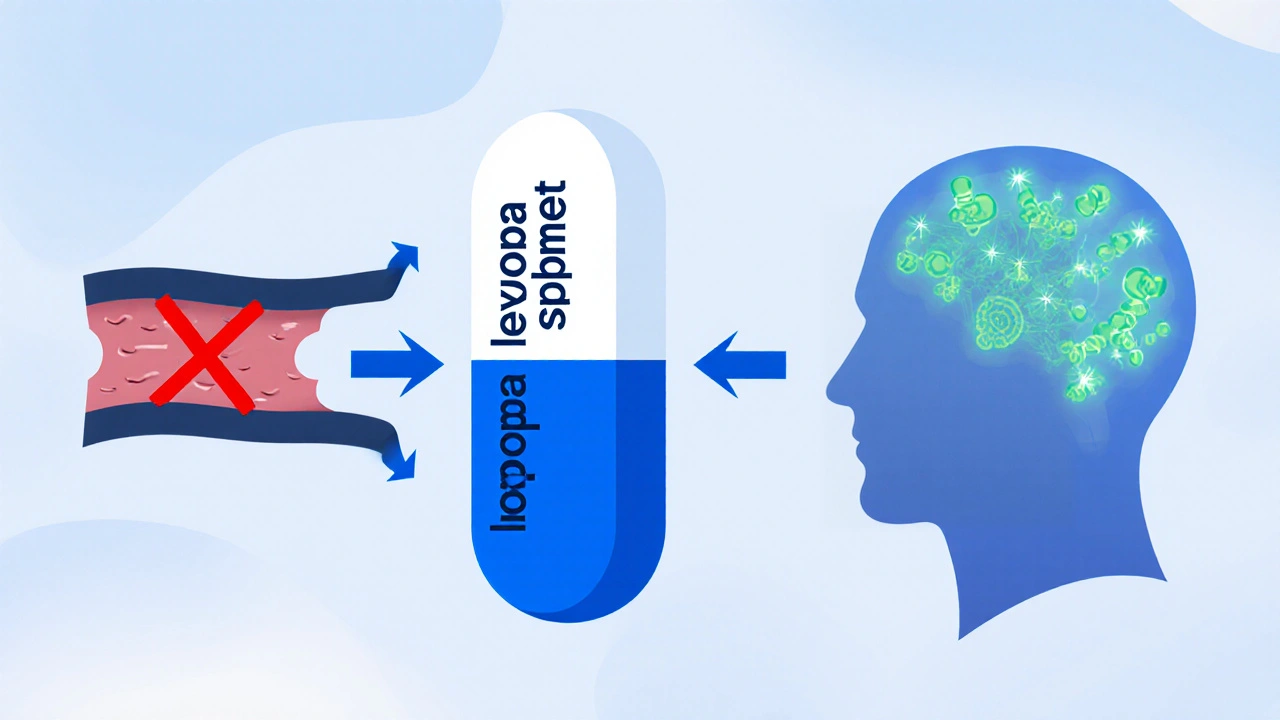Sinemet vs. Other Parkinson’s Meds: How They Stack Up

Parkinson's Medication Comparison Tool
Find Your Best Medication Match
Answer a few questions about your priorities to see which Parkinson's medications might work best for you.
When treating Parkinson’s disease, Sinemet is a combination of carbidopa and levodopa, designed to boost dopamine levels while reducing peripheral side effects. It has been the go‑to therapy for decades, but newer agents promise fewer nausea episodes, smoother motor control, or easier dosing. If you’re weighing Sinemet alternatives, you’ll want a clear picture of how each option measures up on efficacy, side‑effects, convenience, and cost.
What Makes Sinemet Tick?
Carbidopa is a peripheral dopa‑decarboxylase inhibitor that prevents levodopa from turning into dopamine outside the brain. By blocking that conversion, more levodopa reaches the central nervous system and you get a lower dose‑related nausea burden.
Levodopa is the direct precursor of dopamine, the neurotransmitter that’s depleted in Parkinson’s disease. Once inside the brain, levodopa is converted to dopamine, restoring motor function.
Sinemet’s typical regimen starts with low‑dose tablets taken three to four times a day, adjusted upward based on symptom control and side‑effect tolerance. The most common adverse events are nausea, orthostatic hypotension, and dyskinesia after long‑term use.
Key Alternatives on the Market
Below are the major drug classes and specific products that clinicians often consider instead of-or in addition to-Sinemet.
- Stalevo combines levodopa, carbidopa, and the COMT inhibitor entacapone to prolong levodopa’s effect.
- Ropinirole is a non‑ergot dopamine agonist that directly stimulates dopamine receptors.
- Pramipexole another dopamine agonist with a longer half‑life, allowing once‑daily dosing for many patients.
- Entacapone is a catechol‑O‑methyltransferase (COMT) inhibitor used as an add‑on to levodopa/carbidopa to smooth out “off” periods.
- Apomorphine is a rapid‑acting dopamine agonist administered by injection or sublingual film for breakthrough dyskinesia.
- Selegiline an irreversible monoamine oxidase‑B (MAO‑B) inhibitor that modestly raises brain dopamine levels.
Side‑by‑Side Comparison
| Medication | Mechanism | Typical Dosing Frequency | Common Side Effects | Average Monthly Cost (USD) |
|---|---|---|---|---|
| Sinemet | Levodopa + Carbidopa (dopamine precursor + peripheral blocker) | 3-4 times daily | Nausea, orthostatic hypotension, dyskinesia (long‑term) | $30-$70 |
| Stalevo | Levodopa + Carbidopa + COMT inhibitor (entacapone) | 3-4 times daily | Diarrhea, increased dyskinesia, urine discoloration | $100-$150 |
| Ropinirole | Dopamine agonist (non‑ergot) | Once or twice daily | Somnolence, nausea, impulse control disorders | $80-$120 |
| Pramipexole | Dopamine agonist (non‑ergot) | Once daily (extended‑release) or three times daily | Edema, dizziness, compulsive behaviors | $90-$130 |
| Entacapone (add‑on) | COMT inhibitor - extends levodopa half‑life | With each levodopa dose | Diarrhea, orange‑tinted urine, orange‑yellow stool | $50-$80 |
| Apomorphine | Rapid‑acting dopamine agonist | Injection/sublingual as needed (often 5‑10 mg) | Nausea, orthostatic hypotension, site reactions | $200-$300 (per month) |
| Selegiline (MAO‑B inhibitor) | Irreversible MAO‑B inhibition - raises dopamine | Once daily | Hypertension (with tyramine), insomnia | $40-$70 |
Decision Factors You Should Weigh
- Efficacy for Motor Symptoms - Levodopa‑based combos (Sinemet, Stalevo) usually give the strongest “on” response. Dopamine agonists are less potent but can delay the need for levodopa.
- Side‑Effect Profile - If nausea is a deal‑breaker, a dopamine agonist or an MAO‑B inhibitor may feel gentler. However, agonists carry a higher risk of impulse‑control issues.
- Dosing Convenience - Once‑daily extended‑release forms of pramipexole or the patch‑form of rotigotine (not listed) simplify schedules, while Sinemet often needs multiple daily doses.
- Long‑Term Complications - Dyskinesia tends to emerge after several years of levodopa use. Switching earlier to an agonist can postpone it, but may introduce sleep attacks.
- Cost & Insurance Coverage - Generic Sinemet remains the cheapest levodopa option. Newer drugs may be pricey, though many insurers cover them under specialty tiers.
- Patient Age & Disease Stage - Younger patients (<65) often start with agonists to preserve levodopa responsiveness. Older patients may need the stronger motor boost of Sinemet right away.
Pros and Cons at a Glance
| Medication | Pros | Cons |
|---|---|---|
| Sinemet | Strong motor control; well‑studied; inexpensive | Nausea; dyskinesia over time; multiple daily doses |
| Stalevo | Extended “on” time; reduces “off” episodes | Higher cost; more dyskinesia risk |
| Ropinirole | Fewer motor fluctuations early; once‑daily possible | Somnolence; impulse‑control disorders |
| Pramipexole | Long half‑life; once‑daily extended release | Edema; compulsive gambling/sex |
| Entacapone | Boosts levodopa efficiency; cheap add‑on | GI upset; urine discoloration |
| Apomorphine | Rapid rescue for breakthrough “off” | Invasive administration; nausea |
| Selegiline | Gentle dopamine rise; oral daily dose | Dietary tyramine restrictions; modest effect |

How to Transition Safely
Switching from Sinemet to an alternative isn’t a simple “stop‑and‑go” affair. Here’s a practical roadmap:
- Consult a movement‑disorder specialist to assess disease stage and co‑morbidities.
- If moving to a dopamine agonist, start at a low dose (e.g., ropinirole 0.25 mg) and titrate up over 2‑4 weeks while tapering levodopa.
- For add‑on strategies (e.g., entacapone), keep the current Sinemet dose and introduce the COMT inhibitor at the next dose interval.
- Monitor for withdrawal dyskinesia when reducing levodopa quickly; a gradual taper (10‑20 % per week) usually prevents it.
- Track non‑motor symptoms (sleep, mood) because many alternatives shift the side‑effect balance.
Regular follow‑ups during the first three months are critical. Adjustments are often needed as the brain’s dopamine receptors adapt.
Bottom Line: Pick What Fits Your Lifestyle
There’s no one‑size‑fits‑all answer. If you need the strongest motor boost and cost is a concern, Sinemet remains a solid first‑line choice. If you’re younger, worried about nausea or want fewer daily pills, a dopamine agonist like pramipexole or a COMT‑enhanced combo like Stalevo may suit you better. Always weigh efficacy against side‑effects, convenience, and price, and keep an open dialogue with your neurologist.
Can I take Sinemet with a MAO‑B inhibitor?
Mixing levodopa‑carbidopa with an MAO‑B inhibitor (like selegiline) can increase dopamine too much, leading to hypertensive crises. Doctors usually separate them by at least 14 days or choose a different regimen.
Why does dyskinesia develop after years on Sinemet?
Long‑term levodopa creates pulsatile dopamine spikes, which over‑sensitize motor pathways. The brain’s receptors adapt, causing involuntary movements called dyskinesia.
Is Stalevo worth the extra cost?
For patients with frequent “off” periods, the added entacapone can smooth symptom control and reduce the number of daily doses, often justifying the higher price. If your “on” time is already stable, the extra expense may not add value.
Do dopamine agonists cause addiction?
They don’t cause chemical addiction, but they can trigger impulse‑control disorders (gambling, shopping, eating). Monitoring mood and behavior is key, especially in younger patients.
What’s the best way to start apomorphine?
Doctors usually begin with a low titration dose (2‑3 mg) under supervision, combined with anti‑nausea medication for the first 24 hours. It’s reserved for patients with unpredictable “off” episodes.

Andrew Hernandez
October 20, 2025 AT 19:27Thanks for the clear breakdown of the meds.
Alex Pegg
October 21, 2025 AT 03:47Everyone praises levodopa, but the long‑term dyskinesia risk makes me question its supremacy.
Kate McKay
October 21, 2025 AT 12:07If you’re navigating the maze of Parkinson’s treatments, remember you’re not alone in this journey.
Each medication class brings its own set of benefits and drawbacks.
Levodopa‑based combos like Sinemet still deliver the most robust motor improvement for many patients.
That said, the nausea and orthostatic issues can be a real barrier for newcomers.
Dopamine agonists, such as Ropinirole and Pramipexole, often allow a slower progression of motor complications.
They also carry a risk of impulse‑control problems that you have to watch for closely.
COMT inhibitors like Entacapone or Stalevo can smooth out “off” periods when levodopa wears off too quickly.
Keep in mind that adding a COMT inhibitor often means dealing with diarrhea and orange‑tinged urine.
MAO‑B inhibitors, for example Selegiline, are gentler on the gut but require dietary restrictions to avoid hypertensive crises.
Apomorphine offers rapid relief for breakthrough dyskinesia, yet the injection or sublingual route can feel invasive.
Cost is a major deciding factor-generic Sinemet remains the cheapest, while newer agents can strain insurance benefits.
You’ll also want to consider age; younger patients may benefit from delaying levodopa to postpone dyskinesia.
Conversely, older individuals often need the strong symptomatic control that levodopa provides.
When assessing side‑effects, remember that what bothers one patient might be tolerable for another.
Ultimately, the best strategy is a personalized blend, adjusting doses and agents as the disease evolves.
Sebastian Green
October 21, 2025 AT 20:27I hear you, the choices can feel overwhelming.
Rajesh Myadam
October 22, 2025 AT 04:47Your overview is thorough; I’d add that insurance formularies often drive the final decision more than clinical nuance.
Mahesh Upadhyay
October 22, 2025 AT 13:07Listen, the glorification of old‑school Sinemet is a relic of complacent pharma‑driven practice.
Demetri Huyler
October 22, 2025 AT 21:27While your passion is noted, one must appreciate the historical data that underpins levodopa’s efficacy.
JessicaAnn Sutton
October 23, 2025 AT 05:47Precisely; the meta‑analyses demonstrate a statistically significant improvement in UPDRS scores with carbidopa‑levodopa combinations.
Israel Emory
October 23, 2025 AT 14:07Interesting point, Alex! However, many patients tolerate Sinemet well, especially when titrated carefully.
Wesley Humble
October 23, 2025 AT 22:27Indeed, the pharmacokinetic profile of levodopa remains superior in achieving consistent dopaminergic stimulation; 😊 compliance rates improve accordingly.
barnabas jacob
October 24, 2025 AT 06:47Yo, the clinical data is lit, but the cost‑benefit analysis still shows generic Sinemet dominates the market share.
Deja Scott
October 24, 2025 AT 15:07Your summary captures the essential trade‑offs nicely.
jessie cole
October 24, 2025 AT 23:27Indeed, the balance between efficacy and side‑effects is the crux of patient‑centered care, and your comment reinforces that.
Kirsten Youtsey
October 25, 2025 AT 07:47One must also consider the hidden incentives that steer prescribing habits toward patented combos, subtly marginalizing cheaper generics.